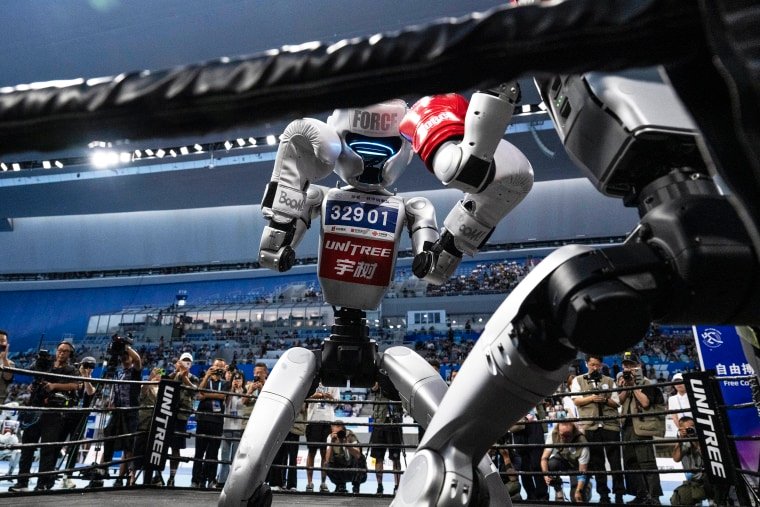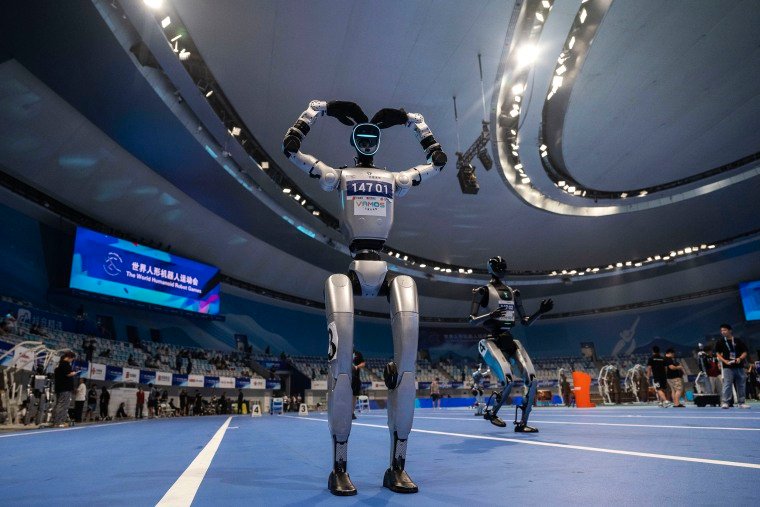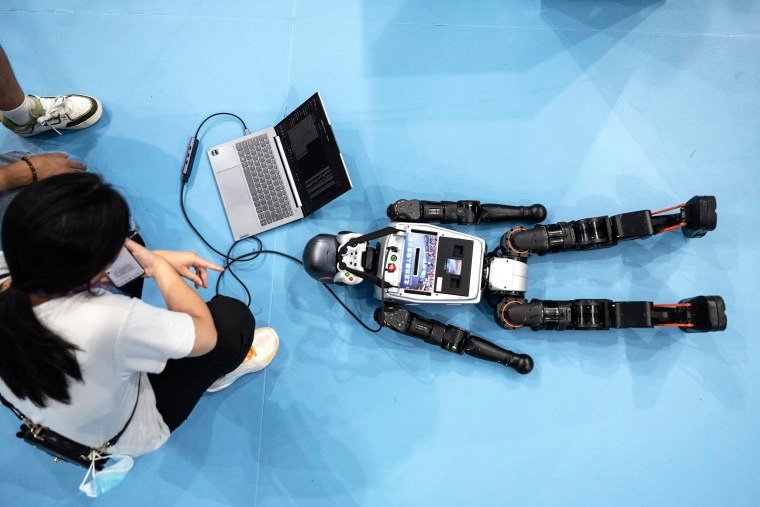AI Research
In another AI push, China holds the world’s first sports event for humanoid robots

BEIJING — They aren’t the most graceful athletes, or the fastest. But they’re learning.
From Friday to Sunday, human handlers from 16 countries put about 500 bipedal robots through various motions to showcase the promise and limits of embodied artificial intelligence at what was billed as the first-ever World Humanoid Robot Games in Beijing.
The robotic participants came in all shapes, sizes and structures and competed in 26 different sports events ranging from running to kickboxing to soccer. The unusual state-backed sports tournament at the National Speed Skating Oval, a Beijing Olympic venue, came as the United States and China race against each other to shape the future of AI.
There were no speed records being set, and many of the athletes were prone to fizzling and face plants. Some robots broke down unexpectedly while competing, while others didn’t complete their tasks as planned. One viral video showed a running robot veering off course and accidentally knocking over a person on the track.
But for the robots’ developers, the games were less about winning or losing and more about testing their agility, endurance and battery life, all of which have made great advances in recent years.
Some humanoids were also competing in more practical job skills, such as sorting medicine and hotel concierge duties.
A team from StarBot, a California-based tech company that specializes in developing robots skilled in customer service, said they were “really excited” to be part of the games.
“We thought it was a really good opportunity to come to China and be in an environment where everything is so modern and up to date,” company representative Gregorio Velasco told NBC News.
StarBot’s machines, developed based on the Chinese-made Unitree model, competed in service-related races as they excel at restaurant scenarios such as taking orders and delivering food to tables, he said.
Going forward, Velasco said, “we hope to be in people’s homes and restaurants, hotels, and I think in the future, many people will have robots involved in their life.”
The venue was packed with spectators who laughed, clapped and rooted for the robot athletes as the games kicked off Friday.
During the tai chi event, a group of judges watched carefully as the robot competitors moved gracefully to the rhythm of soft music in the background, jotting down notes and scoring the performances with the seriousness of an Olympic panel.
“For robots, a single movement needs to be repeated many times before they can perform it with stability,” martial arts judge Zhang Jidong told Chinese state newspaper The Beijing News. “Considering the very short preparation time, the robots’ upper-body movements were impressively smooth.”

The games did not just showcase how far robotics have come and how humanoids might one day be integrated into daily life. They also revealed how heavily China’s government has been backing the development of these technologies, to close the artificial intelligence gap with the United States.
In July, China announced its global action plan for AI just days after the Trump administration released the U.S. version, which experts note is “no coincidence” as the two countries race to win others over to their respective visions for AI governance. Both countries consider AI a national security issue, and the U.S. has sought to restrict China’s access to the advanced semiconductor chips needed to train AI models.
While the U.S. backs market-driven AI in alignment with liberal norms, China promises to help developing countries with AI as a means to promote state control, according to the Atlantic Council, a think tank based in Washington.
Videos of robots dancing, punching and performing have been all over Chinese social media and state TV as Beijing has deepened its AI investment and promotion. In April, the Chinese government organized a half-marathon in Beijing where robots and human runners raced against each other.

For years, Beijing has been funneling tens of billions of dollars into AI research and state subsidies, just as it did with the electric vehicle industry, drawing accusations of unfair competition from Western critics.
While American robot developers such as Boston Dynamics still dominate high-end research and innovation, Chinese companies, spurred by government policy, are focused on mass-producing affordable robots, according to Information Technology and Innovation Foundation, a think tank based in Washington.
Research published by Morgan Stanley predicts that by 2050, China will have 302.3 million humanoid robots in use, well ahead of the U.S. projection of just 77.7 million.
Although the production disparity between the two countries may grow larger, experts said the U.S. will maintain its advantage in total compute capacity, a metric more likely to be the key in deploying and integrating AI systems at scale.

Wang Xiaoyin, a representative from China-based robot developer NexAurora, said robots today still lack a “robust AI brain.”
The “real AI age,” he said, will begin only when robots like the ones competing in Beijing can think and behave independently after training.
While the robots’ performance over the weekend showed that day is still a long way off, the games were part of China’s larger goal: getting ahead in the global race for AI domination, one clunky step at a time.
Janis Mackey Frayer and Dawn Liu reported from Beijing, and Peter Guo reported from Hong Kong.
AI Research
AI in PR Research: Speed That Lacks Credibility

Artificial intelligence is transforming how research is created and used in PR and thought leadership. Surveys that once took weeks to design and analyze can now be drafted, fielded and summarized in days or even hours. For communications professionals, the appeal is obvious: AI makes it possible to generate insights that keep pace with the news cycle. But does the quality of those insights hold?
In the race to move faster, an uncomfortable truth is emerging. AI may make aspects of research easier, but it also creates enormous pitfalls for the layperson. Journalists rightfully expect research to be transparent, verifiable and meaningful. This credibility cannot be compromised. Yet an overreliance on AI risks jeopardizing the very characteristics that make research such a powerful tool for thought leadership and PR.
This is where the opportunity and the risk converge. AI can help research live up to its potential as a driver of media coverage, but only if it is deployed responsibly, and never as a total substitute for skilled practitioners. Used without oversight, or by untrained but well-meaning communicators, it produces data that looks impressive on the surface but fails under scrutiny. Used wisely, it can augment and enhance the research process but never supplant it.
The Temptation: Faster, Cheaper, Scalable
AI has upended the traditional pace of research. Writing questions, cleaning data, coding open-ended responses and building reports required days of manual effort. Now, many of these tasks can be automated.
- Drafting: Generative models can create survey questions in seconds, offering PR teams a head start on design.
- Fielding: AI can help identify fraudulent or bot-like responses.
- Analysis: Large datasets can be summarized almost instantly, and open-text responses can be categorized without armies of coders.
- Reporting: Tools can generate data summaries and visualizations that make insights more accessible.
The acceleration is appealing. PR professionals can, in theory, generate surveys and insert data into the media conversation before a trend peaks. The opportunity is real, but it comes with a condition: speed matters only when the research holds up to scrutiny.
The Risk: Data That Doesn’t Stand Up
AI makes it possible to create research faster, but not necessarily better. Fully automated workflows often miss the standards required for earned media.
Consider synthetic respondents, artificial personas generated by AI to simulate human answers to surveys, trained on data from previous surveys. On the surface, they provide instant answers to survey questions. But research shows they diverge from real human data once tested across different groups and contexts. The issue isn’t limited to surveys. Even at the model level, AI outputs remain unreliable. OpenAI’s own system card shows that despite improvements in its newest model, GPT-5 still makes incorrect claims nearly 10% of the time.
For journalists, these shortcomings are disqualifying. Reporters and editors want to know how respondents were sourced, how questions were framed and whether findings were verified. If the answer is simply “AI produced it,” credibility collapses. Worse, errors that slip into coverage can damage brand reputation. Research meant to support PR should build trust, not risk it.
Why Journalists Demand More, Not Less
The reality for PR teams is that reporters are inundated with pitches. That volume has made editors more discerning, and credible data can differentiate a pitch from the competition.
Research that earns coverage typically delivers three things:
- Clarity: Methods are clearly explained.
- Context: Results are tied to trends or issues audiences care about.
- Credibility: Findings are grounded in sound design and transparent analysis.
These expectations have only intensified. Public trust in media is at a historic low. Only 31% of Americans trust the news “a great deal” or “a fair amount.” At the same time, 36% have “no trust at all,” the highest level of complete distrust Gallup has recorded in more than 50 years of tracking. Reporters know this and apply greater scrutiny before publishing any research.
For PR professionals, the implication is clear: AI can speed up processes, but unless findings meet editorial standards, they will never see the light of day.
Why Human Oversight Is Indispensable
AI can process data at scale, but it cannot replicate the judgment or accountability of human researchers. Oversight matters most in four areas:
- Defining objectives: Humans decide which questions are newsworthy or align with campaign goals and what narratives are worth testing.
- Interpreting nuance: Machines can classify sentiment, but are bad at identifying sarcasm, cultural context and emotional cues that shape meaningful insights.
- Accountability: When findings are published, people – not algorithms – must explain the methods and defend the results.
- Bias detection: AI reflects the limitations of its training data. Without human review, skewed or incomplete findings can pass as fact.
Public opinion reinforces the need for this oversight. Nearly half of Americans say AI will have a negative impact on the news they get, while only one in 10 say it will have a positive effect. If audiences are skeptical of AI-created news, journalists will be even more cautious about publishing research that lacks human validation. For PR teams, that means credibility comes from oversight: AI may accelerate the process, but only people can provide the transparency that makes research media ready.
AI as a Partner, Not a Shortcut
AI is best used strategically. It is as an “assistant” that enhances workflows rather than a substitute for expertise. That means:
- Letting AI handle repetitive tasks such as transcription, always with human oversight.
- Documenting when and how AI tools are used, to build transparency.
- Validating AI outputs against human coders or traditional benchmarks.
- Training teams to understand AI’s capabilities and limitations.
- Aligning with evolving disclosure standards, such as the AAPOR Transparency Initiative.
Used this way, AI accelerates processes while preserving the qualities that make research credible. It becomes a force multiplier for human expertise, not a replacement for it.
What’s at Stake for PR Campaigns
Research has always been one of the most powerful tools for earning media. A well-executed survey can create headlines, drive thought leadership and support campaigns long after launch. But research that lacks credibility can do the opposite, damaging relationships with journalists and eroding trust.
Editors are paying closer attention to how AI is being used in PR. Some are experimenting with it themselves, while exercising caution. In Cision’s 2025 State of the Media Report, nearly three-quarters of journalists (72%) said factual errors are their biggest concern with AI-generated material, while many also worried about quality and authenticity. And although some reporters remain open to AI-assisted content if it is carefully validated, more than a quarter (27%) are strongly opposed to AI-generated press content of any kind. Those figures show why credibility cannot be an afterthought: skepticism is high, and mistakes will close doors.
The winners will be teams that integrate AI responsibly, using it to move quickly without cutting corners. They will produce findings that are timely enough to tap into news cycles and rigorous enough to withstand scrutiny. In a crowded media landscape, that balance will be the difference between earning coverage and being ignored.
Conclusion: Credibility as Currency
AI is here to stay in PR research. Its role will only expand, reshaping workflows and expectations across the industry. The question is not whether to use AI, but how to use it responsibly.
Teams that treat AI as a shortcut will see their research dismissed by the media. Teams that treat it as a partner – accelerating processes while upholding standards of rigor and transparency – will produce insights that both journalists and audiences trust.
In today’s environment, credibility is the most valuable currency. Journalists will continue to demand research that meets high standards. AI can help meet those standards, but only when guided by human judgment. The future belongs to PR professionals who prove that speed and credibility are not in conflict, but in partnership.
AI Research
High Schoolers, Industry Partners, and Howard Students Open the Door to Tech at the Robotics and AI Outreach Event

Last week in Blackburn Center, Howard University welcomed middle school, high school, and college students to explore the rapidly expanding world of robotics over the course of its second Robotics and AI Outreach Event. Teams of high school students showcased robots they built, while representatives from partnering Amazon Fulfillment Technologies, FIRST Robotics, the U.S. Navy and U.S. Army Research Laboratories, and Viriginia Tech gave presentations on their latest technologies, as well as ways to get involved in high-tech research.
Across Thursday and Friday, Howard students and middle and high schoolers from across the DMV region heard from university researchers creating stories with generative AI and learned how they can get involved in STEM outreach from the Howard University Robotics Organization (HURO) and FIRST Robotics. They also viewed demonstrations of military unmanned ground vehicles and the Amazon Astro household robot. The biggest draw, however, was the robotics showcase in the East Ballroom.
Over both days, middle and high school teams from across the DMV presented their robots as part of the FIRST Tech Challenge (FTC) and FIRST Robotics Competition, during which they were tasked with designing a robot within six weeks. The program is intensive and gives students a taste of a real-world engineering career, as the students not only design and build their entries, but also engage in outreach events and raise their own funding each year.
“It’s incredible,” said Shelley Stoddard, vice president of FIRST Chesapeake. “I liken our teams to entrepreneurial startups. Each year they need to think about who they’re recruiting, how they’re recruiting; what they’re going to do for fundraising. If they want to have a brand, they create that, they manage that. We are highly encouraging of outreach because we don’t want it to be insular to just their schools or their classrooms.”
Reaching the Next Generation of Engineers
This entrepreneurial spirit carries across the teams, such as the Ashburn, Virginia-based BeaverBots, who showed up in matching professional attire to stand out to potential recruits and investors as they presented three separate robots they’ve designed over the years — the Stubby V2, Dam Driver V1, and DemoBot — all built for lifting objects. Beyond already being skilled engineers and coders in their own right, the team has a heavy focus on getting younger children into robotics, even organizing their own events.
“One of the biggest things about our outreach is showing up to scrimmages and showing people we actually care about robotics and want to help kids join robotics,” said team member and high school junior Savni (last name withheld). “So, for example we’ve started a team in California, we’ve mentored [in] First Lego League, and we’ve hosted multiple scrimmages with FTC teams.”
“We also did a presentation in our local Troop 58 in Ashburn, where we showed our robot and told kids how they can get involved with FIRST,” added team vice-captain Aryan. “Along with that, a major part of our fundraising is sponsorship and matching grants. We’ve received matching grants from CVS, FabWorks, and ICF.”
This desire to pay it forward and get more people involved in engineering wasn’t limited to the teams. Members of the student-run HURO were also present, putting on a drone demo and giving lectures advocating for more young Black intellectuals to get into science and engineering.
“Right now, we’re doing a demo of one of our drones from the drone academy,” explained senior electrical engineering major David Toler II. “It’s a program we’ve put on since 2024 as a way to enrich the community around us and educate the Black community in STEM. We not only provide free drones to high schools, but we also work hands-on with them in very one-on-one mentor styles to give them knowledge to build on themselves and understand exactly how it works, why it works, and what components are necessary.”
Building A Strong Support Network
HURO has been involved with the event from the beginning. Event organizer and Howard professor Harry Keeling, Ph.D., credits the drone program for helping the university’s AI and robotics outreach take flight.
“It started with the drone academy, then that expanded through Dr. Todd Shurn’s work through the Sloan Foundation in the area of gaming,” explained Keeling. “Then gaming brought us to AI, and we got more money from Amazon and finally said ‘we need to do more outreach.’”
Since 2024, Keeling has been working to bring more young people into engineering and AI research, relying on HURO, other local universities and high schools, industry partners like Amazon, and the Department of Defense, to build a strong network dedicated to local STEM outreach. Like with FIRST Robotics, a large part of his motivation with these growing partnerships is to prepare students for successful jobs in the industry.
“We tell our students that in this field, networking is how you accomplish career growth,” he said. “None of us knows everything about what we do, but we can have a network where we can reach out to people who know more than we do. And the stronger our network is, the more we are able to solve problems in our own personal and professional lives.”
At next year’s event, Keeling plans to step back and allow HURO to take over more of the organizing and outreach, further bringing the next generation into leadership positions within the field. Meanwhile, he is working with other faculty members across the university to bring AI to the curriculum, further demystifying the technology and ensuring Howard students are prepared for the future.
For Keeling, outreach events like this are vital to ensuring that young people feel confident in entering robotics, rather than intimidated.
“One thing I realized is young people gravitate to what they see,” he said. “If they can’t see it, they can’t conceive it. These high schoolers[and] middle schoolers are getting a chance to rub elbows with a lot of professionals [and] understand what a roboticist ultimately might be doing in life.”
He hopes that his work eventually makes children see a future in tech as just as possible as any other field they see on TV.
“I was talking with my daughters, and I asked them at dinner ‘what do you want to be when you grow up?’” Keeling said. “And my youngest one said astronauts, and an artist, and a cook. Now hopefully one day, one of those 275 students that were listening to my presentation will answer the question with ‘I want to be an AI expert. I want to be a roboticist.’ Because they’ve come here, they’ve seen and heard what they can do.”
AI Research
CrowdStrike bets big on agentic AI with new offerings after $290M Onum buy

The real innovation in CrowdStrike’s Agentic Security Platform, then, is that the top two levels of the enterprise graph “act as abstraction layers that hide all this complexity away from both human and agentic AI users,” Zaitsev said. “The semantic data model essentially gives you one common language, a Rosetta Stone that we can use to abstract away the differences between all these different security domains, all these different vendors, and proprietary schemas. And we do it essentially in plain, simple English.”
An example illustrates how this innovation operates. “One vendor like CrowdStrike might call something an IPv4 in a log event, and another vendor may call something an IP underscore four,” Zaitsev said. “As humans, we kind of intuitively know if you have a cybersecurity background, they’re talking about an IP address version four.”
But “protocol machines don’t typically work that way, though they need that mapping done for them. So not only have we done that mapping without disturbing the underlying data, but we’re also using plain, simple semantic meaning — concepts that any agentic system will understand out of the box without any specialized training or fine-tuning,” he said.
-

 Business3 weeks ago
Business3 weeks agoThe Guardian view on Trump and the Fed: independence is no substitute for accountability | Editorial
-
Tools & Platforms1 month ago
Building Trust in Military AI Starts with Opening the Black Box – War on the Rocks
-

 Ethics & Policy2 months ago
Ethics & Policy2 months agoSDAIA Supports Saudi Arabia’s Leadership in Shaping Global AI Ethics, Policy, and Research – وكالة الأنباء السعودية
-

 Events & Conferences4 months ago
Events & Conferences4 months agoJourney to 1000 models: Scaling Instagram’s recommendation system
-

 Jobs & Careers3 months ago
Jobs & Careers3 months agoMumbai-based Perplexity Alternative Has 60k+ Users Without Funding
-

 Podcasts & Talks2 months ago
Podcasts & Talks2 months agoHappy 4th of July! 🎆 Made with Veo 3 in Gemini
-

 Education3 months ago
Education3 months agoVEX Robotics launches AI-powered classroom robotics system
-

 Education2 months ago
Education2 months agoMacron says UK and France have duty to tackle illegal migration ‘with humanity, solidarity and firmness’ – UK politics live | Politics
-

 Podcasts & Talks2 months ago
Podcasts & Talks2 months agoOpenAI 🤝 @teamganassi
-

 Funding & Business3 months ago
Funding & Business3 months agoKayak and Expedia race to build AI travel agents that turn social posts into itineraries

